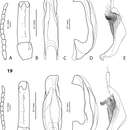Description
provided by Zookeys
Size and shape: Beetle small (TL-H 3.0–3.4 mm, TL 3.35–3.85 mm, MW 1.6–1.8 mm), with oblong-oval habitus, broadest at elytral middle. Coloration: Head reddish brown to dark brown; pronotum dark brown, with reddish sides; elytra uniformly dark brown, except narrow reddish sutural bands in some specimens; head appendages yellowish-red to reddish, legs darker, especially metathoracic legs; beetles generally paler if teneral (Fig. 44).
Surface sculpture: Head with dense punctation (spaces between punctures 1–3 times size of punctures), evidently finer and sparser anteriorly; diameter of punctures smaller than diameter of cells of microreticulation. Pronotum with much sparser and finer punctation than on head. Elytra with extremely sparse and fine punctation. Head, pronotum, and elytra with weakly impressed microreticulation, dorsal surface, thus, shiny. Head with microreticulation stronger. Metaventrite and metacoxa distinctly microreticulate, metacoxal plates with longitudinal strioles and transverse wrinkles. Abdominal sternites with distinct microreticulation, strioles, and fine sparse punctation, coarser and denser on two last abdominal sternites.
Structures: Pronotum without lateral bead. Base of prosternum and neck of prosternal process with distinct ridge, anteriorly rounded, smooth, with very small anterolateral extensions. Blade of prosternal process lanceolate, relatively broad, slightly convex, with distinct bead and few setae; neck and blade of prosternal process evenly jointed. Abdominal sternite 7 broadly rounded apically, in some species broadly truncate.
Male: Antennomeres 3–10 slightly stout (Fig. 18A). Protarsomere 4 with middle-sized, slender, evidently curved anterolateral hook. Protarsomere 5 ventrally with anterior row of 9 short setae and posterior row of 3 short setae (Fig. 18B). Abdominal sternite 7 with 3–7 lateral striae on each side. Median lobe with weak submedian constriction in ventral view and elongate apex in lateral view (Figs 18C, D). Paramere with notch on dorsal side and subdistal part short and small, with large brush of thick, somewhat flattend, long, curved at apex setae (Fig. 18E).
Female: Antennae slightly more slender, abdominal sternite 7 without striae.
- license
- cc-by-3.0
- copyright
- Helena V. Shaverdo, Suriani Surbakti, Lars Hendrich, Michael Balke
- bibliographic citation
- Shaverdo H, Surbakti S, Hendrich L, Balke M (2012) Introduction of the Exocelina ekari-group with descriptions of 22 new species from New Guinea (Coleoptera, Dytiscidae, Copelatinae) ZooKeys 250: 1–76
- author
- Helena V. Shaverdo
- author
- Suriani Surbakti
- author
- Lars Hendrich
- author
- Michael Balke
Distribution
provided by Zookeys
Indonesia: Papua Province: Nabire and Paniai Regencies. This species is known only from the type locality area (Fig. 50).
- license
- cc-by-3.0
- copyright
- Helena V. Shaverdo, Suriani Surbakti, Lars Hendrich, Michael Balke
- bibliographic citation
- Shaverdo H, Surbakti S, Hendrich L, Balke M (2012) Introduction of the Exocelina ekari-group with descriptions of 22 new species from New Guinea (Coleoptera, Dytiscidae, Copelatinae) ZooKeys 250: 1–76
- author
- Helena V. Shaverdo
- author
- Suriani Surbakti
- author
- Lars Hendrich
- author
- Michael Balke

